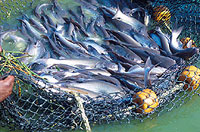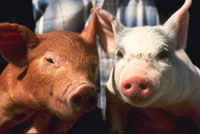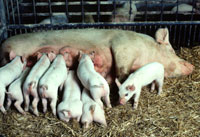Last January, inspectors with the U.S. Food and Drug Administration paid a visit to the University of Illinois, where researchers have been studying the DNA of pigs. The pig project, based in Champaign-Urbana, is one of dozens of experiments being conducted across the country in which scientists are altering the genetic structure of animals in hopes of making them fatter, healthier, and more profitable.

Pigging out.
Photo: USDA.
In the University of Illinois project, cow genes were inserted into sows to increase their milk production, and a synthetic gene was added to make milk digestion easier for the piglets, thereby causing them to grow faster. But instead of the experimental swine being destroyed, as required by the FDA, 386 piglets were sold to livestock brokers, who then sold them to slaughterhouses, who sold them to grocery stores, who sold them to consumers as pork chops, sausage, and bacon.
University officials claim the piglets did not inherit the genetic baggage of their moms, and the government does not believe the incident presented a public-health risk. But the slipup is emblematic of a federal regulatory system that is behind the times when it comes to the next phase of bioengineered food: genetically modified animals.
Over the past five years, GM soybeans and corn have become mainstays in processed food sold in the United States, despite nagging questions about the safety of the products and their potential capacity to cause ecological harm. Now, scientists, environmentalists, and food-safety advocates are concerned that GM meat, eggs, and milk could follow in the footsteps of transgenic crops, becoming a part of the U.S. diet before they have been shown to be safe for humans, animals, and the environment.
Universities and biotechnology companies are conducting experiments that mix and match genes from different organisms to produce animals that could not occur in nature: bioengineered salmon that grow five times as fast as their wild cousins, hens genetically manipulated to lay low-cholesterol eggs, cows with disease-resistant genes, chickens that produce anti-cancer drugs. Some say this work holds great promise for preventing disease, boosting agricultural productivity, and eradicating world hunger. But public-interest groups worry that in the absence of a unified regulatory system, the patchwork of outdated rules applied by different federal agencies could jeopardize food safety and the environment.
Just Say No to Drug-Style Reviews
To date, no GM animals have been approved for sale within the U.S. food industry, and it will probably be several years before genetically modified eggs, milk, and meat make their way into U.S. grocery stores and restaurants. The FDA is currently reviewing 10 applications from companies seeking to sell GM animal products to consumers — but rather than evaluating these products as food, the FDA is reviewing them under the rules that govern new drugs for animals. The agency reasons that adding a foreign substance — genes from another organism or synthetic genes — to an animal’s DNA is similar to feeding the animal a drug because it creates a physical change in the animal, such as faster growth or disease resistance.
Jane Rissler, a senior staff scientist for the Union of Concerned Scientists, calls the use of the drug rule to regulate GM animals a “contortion.” Rissler spent four years at the U.S. EPA helping to formulate biotechnology regulations before joining UCS, a Cambridge, Mass.-based nonprofit, in 1993. She is concerned about the use of the drug law to regulate GM animals because it “is weak on the environment and it allows zero public participation.”

A system in need of chicks and balances.
Photo: USDA.
Under the animal drug law, the FDA cannot discuss anything about the GM animal products currently being reviewed — not the names of the companies involved, the types of animals being modified, the ways their genetic structures have been altered, or the potential effects on food safety, animal health, or the environment. “We cannot reveal that type of information. It’s considered a violation of our rules,” says Linda Grassie, an FDA spokesperson. The agency will issue a report on its findings only after a product has been approved and gone on the market.
By contrast, when Procter & Gamble, the makers of Olestra, asked the FDA for permission to add its artificial fat substitute to potato chips, the controversial product was evaluated under food-additive laws. In that process, the FDA files a notice in the Federal Register and public-interest groups collect and present scientific data to the FDA in writing and at open hearings.
The secretive process now being used to review GM animals is at odds with what the American people seem to want. A 2001 survey conducted by the Pew Initiative on Food and Biotechnology indicated that people desire more information about GM food. Sixty-five percent of respondents were concerned about eating bioengineered food and 45 percent lacked confidence in the government’s ability to ensure the safety of such food.
“A large element of what people are looking for with this technology is having a process that is not only scientifically sound, but having a process that the public can trust,” says Michael Taylor, former deputy commissioner for policy at the FDA. “That transparency is an important part of public confidence in the outcome.”
Taylor was a contributing author to a 2002 National Academy of Sciences report on GM animals that noted several food-safety concerns, including allergies, digestive disorders, and antibiotic resistance. According to the report, people with weak digestive systems — such as those with gastroenteritis — could absorb whole proteins into their blood streams, potentially causing allergic reactions. Infants in particular could be threatened, because their digestive systems are not fully developed. But people with healthy digestive tracts also could be at risk: “Food products containing antimicrobial proteins might present a food safety concern in view of their potential to alter the balance of consumers’ intestinal flora, and might foster the evolution of microbial strains resistant to specific agents,” the report says.
What Price Cheap Salmon?
Many scientists also worry about the ecological effects of tinkering with the genetic structure of animals. On the bright side, some environmental problems could be mitigated by bioengineered animals, such as pigs that produce low-phosphorus poop (which would cut down on emissions of methane, a greenhouse gas) and fluorescent, color-coded fish that would indicate the presence of different water pollutants.

Something’s fishy: bioengineered catfish.
Photo: USDA.
But there is concern that GM animals, especially fish, could escape from holding pens and breed with wild populations, causing dramatic shifts in ecosystems. Scientists at Purdue University in West Lafayette, Ind., described a scenario in which fish engineered to grow faster would compete with wild fish for food and mating partners, potentially driving them to extinction. Opponents of genetic modification worry that a bioengineered salmon currently being reviewed by the FDA could cause Atlantic salmon, already listed as an endangered species, to become extinct.
“In return for possibly slightly cheaper salmon, you run the risk of wiping out wild salmon populations,” says Jean Halloran, director of the Consumer Policy Institute at Consumers Union, the New York research institute that publishes Consumer Reports. “Yeah, I guess it would be an advantage if [salmon] were cheaper, but at what price?”
Under the current rules, the FDA — not the EPA — is responsible for environmental assessments of GM animal projects; these assessments are also conducted without public input. “The FDA is absolutely not qualified to regulate the environmental risks of any animals,” Rissler says. “They are not environmental specialists.” The EPA studies the environmental risks posed by GM crops, and Rissler says the agency should also assess the potential ecological impacts of bioengineered animals, because its scientists have the expertise to ask the right questions.
The FDA insists it is qualified, even though its primary mission is not environmental regulation. “When we have expertise deficiencies in a particular area, we go out and get experts,” says John Matheson, a senior regulatory review scientist for the FDA’s Center for Veterinary Medicine. Matheson, who is an aquatic ecologist, says that in the case of the GM salmon, the FDA is working with the EPA and the U.S. Fish and Wildlife Service to conduct a thorough review. However, according to the National Academy of Sciences report, the FDA does not have the legal authority to deny a GM animal application based on an environmental assessment.
Just Eat It?
Until the glitch at the University of Illinois was discovered a few months ago, the FDA did not require researchers to inform them that they were conducting GM animal experiments. Nor did they make it clear to research organizations that GM animals could not be sold into the commercial food supply. In fact, the Illinois researchers were working closely with the FDA, and still did not understand the rules governing their experimental animals.
In May, the FDA sent a letter to all land-grant universities reminding researchers that their work “may require” licensing under the animal drug law. “Because much is yet to be learned about the positive and negative facets of this type of research, it is imperative that all safety regulations be followed scrupulously,” the FDA letter admonished. That seems like a reasonable request — but, as Halloran of Consumers Union puts it, “I can’t imagine how a researcher would know what the rules are, because they don’t exist in writing.”

Pork: the other genetically engineered meat.
Photo: USDA.
The agency is hoping to have voluntary guidelines for applicants completed within a year, the FDA’s Matheson says. “With animal biotech, there’s such a diversity; it’s hard to anticipate the next one to come in the door,” he says. Because the technology is new, “we’re not yet in a place to decide in stone what kind of requirements might be applied.”
Public-interest groups say it’s time for the FDA to start deciding. They’re calling on the agency to develop regulations specifically for bioengineered food products rather than trying to adapt old rules, intended for conventional food and drugs, to a radically new technology. These new regulations, they say, could spell out the roles of different federal agencies and could require applicants to follow specific testing criteria on matters such as sample sizes and duration of experiments. They also could outline a public participation process and require the labeling of products containing genetically engineered organisms — something that is not now done.
“The public is currently in the situation of not even having awareness that anyone is thinking about genetically engineering animals for human consumption,” Halloran says. “And the way the structure is currently set up, that’s going to go on until one day the FDA says, ‘We’ve just approved a genetically engineered animal and we’re not going to label it. So, here it is; eat it.'”


